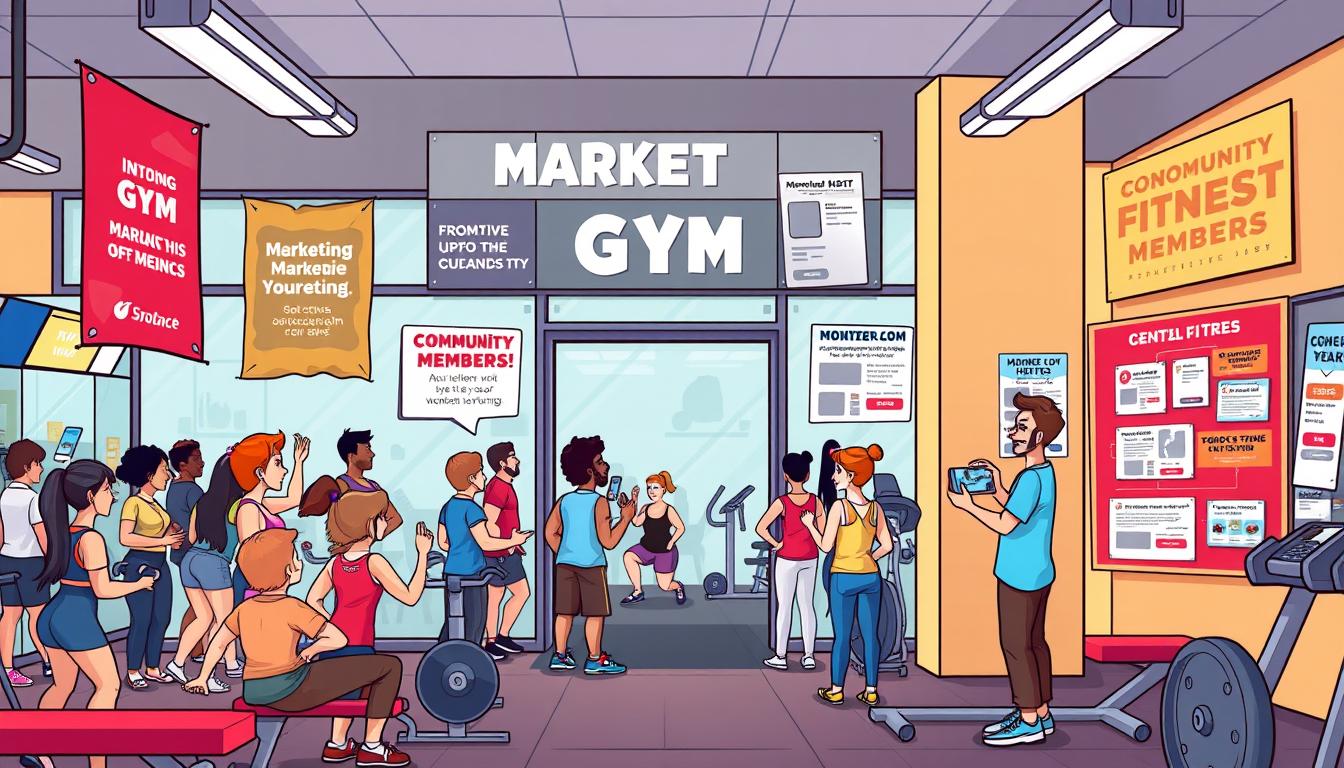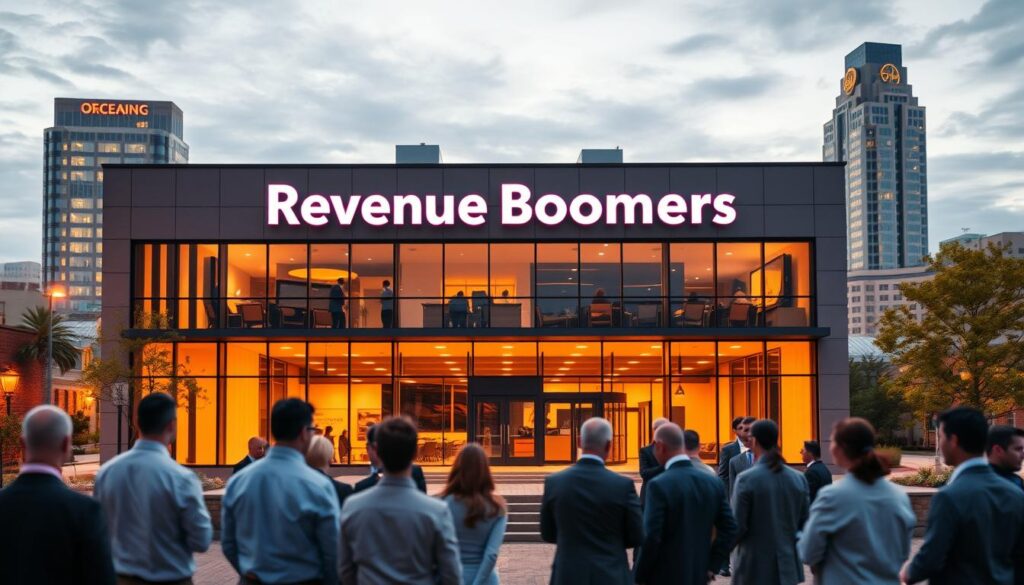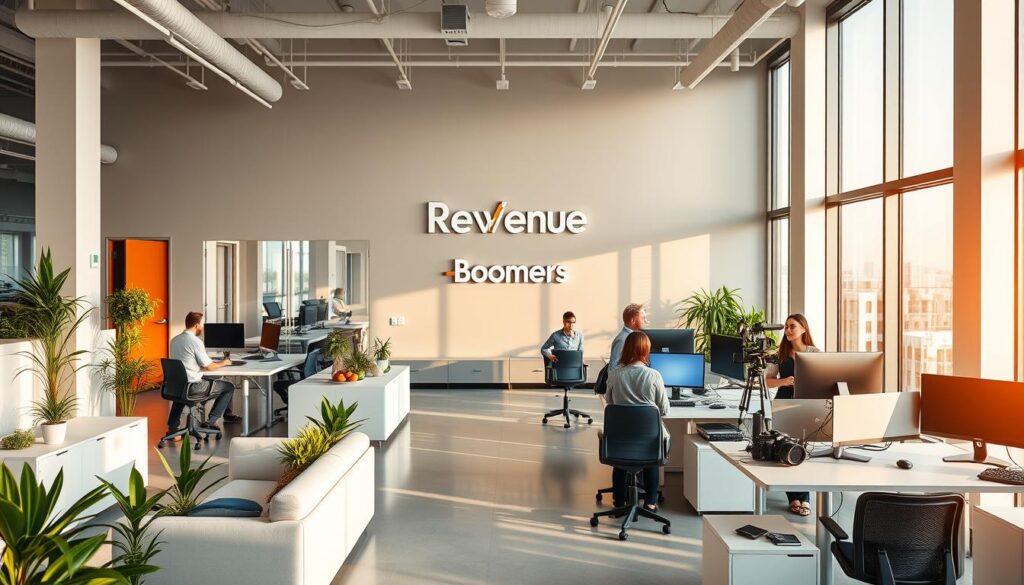Ever wondered why some gyms do great while others barely stay open? In today’s world, good marketing for gyms is key. By using smart strategies, gyms can pull in new members and keep the ones they have. This article will show how to boost your gym’s success through local partnerships and fun promotions.
Gyms face a lot of competition, with people seeing almost 150 ads every day. It’s important for gyms to stand out and speak to their audience. By focusing on personal touches and building a community, you can attract a wide range of people. Plus, offering different classes and listening to what members say can make them happier and more loyal.
By using social media and email marketing, your gym can get more people involved and seen. For more on how SEO can help your gym, check out this insightful resource.
Key Takeaways
- Emphasizing community engagement through events boosts member loyalty.
- Utilizing social media effectively can exponentially increase your gym’s visibility.
- Offering incentives like discounts can enhance customer retention strategies.
- Personalized attention is crucial in motivating and attracting new members.
- Collaborating with local businesses opens doors for mutually beneficial promotions.
Understanding Your Target Audience
Knowing who your audience is is key to selling gym memberships well. By figuring out who might join, gyms can shape their services to meet those needs. The fitness world is booming, with new gyms popping up everywhere. This means gyms can reach out to many different groups of people.
Identifying Potential Members
Figuring out who might join involves looking at age, gender, and lifestyle. There are different age groups like millennials, Gen X, baby boomers, and seniors. Each group has its own fitness needs, helping gyms tailor their services.
- Young adults (18–25 years) might look for affordable options and trendy classes.
- Professionals (26–40 years) often want something convenient and efficient.
- Middle-aged folks (41–60 years) might enjoy low-impact activities like yoga.
- Seniors (60+ years) usually seek specialized programs and staff who know what they’re doing.
Analyzing Member Demographics
Looking into member demographics helps gyms know who they want to attract. For example, men might like strength training, while women might prefer group classes. This info helps gyms fine-tune their marketing and offer what each group wants.
Creating Member Personas
Creating detailed profiles of members helps with communication. By using data, gyms can send messages that really speak to their audience. Tools like Exercise.com help gather the right info for these profiles. This software tracks how members behave, helping gyms segment them by goals like:
- Weight loss fans who like structured plans and personal training.
- Muscle builders who need lots of free weights and bodybuilding gear.
- General fitness fans who want a mix of cardio and flexibility training.
Developing Your Unique Selling Proposition
Creating a unique selling proposition (USP) is key for gyms to shine in a crowded market. A USP helps gyms talk to potential members clearly. It’s the base for gym branding and positioning. By offering something unique, gyms can attract and keep more members.
Differentiating Your Gym
Finding what makes your gym special is crucial for a strong USP. This could be special classes, personal training, or a welcoming community. Knowing who you’re aiming for through market research helps you offer what they want. Using stories of success can make your gym seem more trustworthy to newcomers.
Crafting Compelling Offers
After setting your USP, it’s time to make it into real promotions. You might offer discounts, free trials, or special class access. A clear USP can make your brand stick in people’s minds and get them talking. Keeping your branding consistent online and in person is important. Using SEO and social media can help spread the word about your gym.
| Gym USP Strategies | Impact on Members |
|---|---|
| Niche targeting | Increased engagement and loyalty |
| Customer testimonials | Enhanced credibility and trust |
| High-quality content | Greater brand recognition |
| Seasonal promotions | Attractive offers for new members |
| Community events | Strengthened local connections |
Building an Engaging Online Presence
An engaging online presence is key for gyms to attract new members and keep current ones. The digital world offers many chances to connect with people. It’s important to have a good platform and social media plans.
Creating a User-Friendly Website
A website that’s easy to use is crucial. It should share important gym info like class times, membership options, and how to get in touch. The site should be simple to navigate.
Key parts of a great website include:
- Responsive Design: Works on all devices, from computers to phones.
- Fast Load Times: Keeps visitors interested by loading quickly.
- Clear Calls-to-Action: Helps users sign up or reach out to the gym.
Leveraging Social Media Platforms
Social media boosts a gym’s online presence through good engagement. It helps connect with members and potential ones, creating a community feel. Tools like Facebook Insights help understand who’s following and what they like.
Here are ways to improve gym social media:
| Platform | Advantages | Ideal Content Type |
|---|---|---|
| Visual content and community engagement | Images and Stories showcasing success | |
| YouTube | Longer video content for tutorials and tips | In-depth fitness plans and success stories |
| Wide reach and targeted ads | Event promotions and community updates | |
| Professional networking and corporate wellness | Industry-related articles and programs |
Using content from members makes the brand more real. Hosting challenges and rewarding participants can unite people. Posting 80% of the time to educate or inspire is a good rule.
Using videos on TikTok and Instagram Reels can really grab attention. It can turn viewers into members. With these tactics, gyms can build a strong online presence and connect deeply with their community.
Content Marketing Strategies for Gyms
Effective gym content marketing is key to attracting and keeping members. A diverse content strategy boosts engagement and makes the gym a fitness leader. By using blogs and videos, gyms can get noticed and attract those looking for fitness tips.
Blogging for Your Gym
Keeping a blog is vital for sharing fitness tips, local events, and nutrition advice. Content that speaks to your audience builds trust and keeps them coming back. At least 80% of people might try a gym after reading about it online.
Using SEO in blogs can increase traffic and improve rankings. This leads to more members joining the gym.
Video Content and Tutorials
Video content is a strong tool for gym marketing. It can show workout routines, member success stories, and fitness challenges. With YouTube having over 2.68 billion users, gyms can connect with many people.
Real stories in videos attract 80% of consumers who want genuine experiences. Videos help gyms share their stories, boosting engagement and membership.
Effective Email Marketing Campaigns
Email marketing is a key tool for gyms to keep members and attract new ones. A good email strategy starts with a solid email list. It also means direct talks with both current and potential members. Using gym email marketing tips, templates, and stats can help boost engagement and revenue.
Building Your Email List
Start by making your website’s opt-in forms easy to use. Also, ask for sign-ups when people visit your gym. Give them something special, like workout plans or event access, to grow your list. Knowing what your members like helps you send emails that really speak to them.
Designing Engaging Newsletters
Newsletters keep your gym on people’s minds. Mix in tips, nutrition advice, and success stories. Use different emails for different groups to make your content more personal. Newsletters full of useful info build loyalty.
Don’t forget to highlight special deals for loyal members. Use automated emails to send out info based on what members do. This keeps your messages timely and relevant.
These tactics can boost your gym’s engagement and success. Keep an eye on how your emails do to make them better. For more tips on SEO and growing your gym, check out this guide.
Utilizing Local SEO Techniques
Local SEO is key for gyms to reach out to potential members. A strong online presence helps them show up in local searches. Google My Business is a big help, offering vital info that draws in visitors.
Importance of Google My Business
Google My Business is a must for local SEO in gyms. Keeping your profile up-to-date boosts your chances of being in the local map pack. This can lead to more visits and sales.
It’s clear that a detailed profile is crucial. It makes your gym more likely to be seen and chosen by locals.
Optimizing for Local Searches
For better local SEO, gyms need to do some smart keyword research. With 1.8 million “gym near me” searches each month, being found is key. Using the right keywords and content can really help.
Social media also plays a role. Likes, comments, and shares can help your gym show up higher in searches. This is especially true for Instagram and Facebook.
Keeping an eye on your local search rankings is important. Engaging with your community online can build stronger ties. For more tips on local SEO for small businesses, check out this guide.
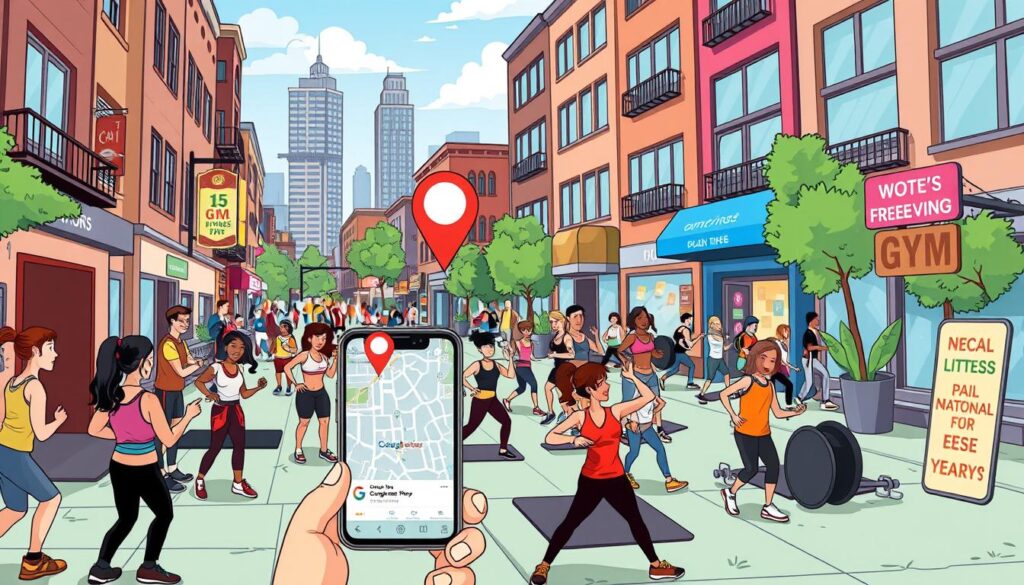
| Local Search Statistics | Implications for Gyms |
|---|---|
| 76% of mobile searches for nearby businesses result in a visit within a day | Opportunity to increase foot traffic and memberships |
| 61% of consumers search locally every day | Consistent engagement through local SEO is essential |
| Google changes its search algorithm 500-600 times a year | Staying updated with SEO best practices is critical for visibility |
| 28% of mobile local searches lead to a purchase | Effective local SEO can convert searches into memberships |
Running Targeted Advertising Campaigns
To reach potential members, gyms need targeted ads. This method lets them talk directly to their best customers. It uses many platforms to hit the right audience, boosting chances of getting new members.
Paid Social Media Ads
Sites like Facebook and Instagram are great for gym ads. Gyms can show off cool offers and features. They can also talk directly to people who might join.
Good ads target the right people based on what they like and do. For example, Anytime Fitness uses catchy pictures and clear calls to action. This helps people find their gym app easily.
Google Ads for Gyms
Google Ads is another key tool for gyms. It helps them show up in local searches for fitness. Ads with the right keywords draw in people looking for gym memberships.
Success stories show PPC ads can get over 10% of people to join. Gyms that use Google Ads and good landing pages get more people interested and signing up.
Creating Referral Programs
Referral programs are a key part of gym marketing. They use current members to bring in new ones. This method helps build loyalty and creates a strong community feeling.
By offering rewards for referrals, gyms can grow their network of supporters. This approach is powerful for attracting new clients.
Incentivizing Current Members
To make a referral program work, you need a clear plan. Offering discounts or gym credits is a good start. But, being creative can make it even better.
Unique rewards like special fitness challenges or events can really get people talking. These activities make the gym feel like a community. And, they help keep new members coming back.
Building a Community Atmosphere
A welcoming gym is key to keeping members happy. Referral programs can help make the gym feel like a community. By getting members involved in social media challenges or events, you build a strong bond.
Working with local businesses can make these activities even more appealing. It’s a win-win for everyone. A good referral system works well with online tools and focuses on building relationships.
Showing appreciation through referral rewards makes members feel valued. Investing in referral programs can really boost your gym’s success and create a sense of partnership.
| Referral Strategies | Potential Incentives |
|---|---|
| Referral Appreciation Events | Exclusive event entries |
| Financial Incentives | Discounts and gym credits |
| Tiered Referral Systems | Mystery gifts and VIP treatment |
| Fitness Challenges | Gifts for participants and winners |
| Social Media Challenges | Special recognition and rewards |
Offering Promotions and Discounts
Well-planned promotions and discounts can really help gyms grow. They attract new members and keep current ones coming back. By timing promotions with big events, gyms grab attention. Knowing what works best helps them create a strong marketing plan.
Seasonal Promotions
Seasonal deals create a rush to join. Here are some ideas:
- New Year’s Resolution Discounts: Big savings for those setting fitness goals.
- Summer Membership Drives: Special deals for families during school breaks.
- Valentine’s Day Membership Specials: Discounts for couples to join together.
- Holiday Fitness Challenges: Fun competitions with prizes.
Membership Loyalty Discounts
Keeping members happy with loyalty discounts is key. Here are some ways to do it:
- Renewal Discounts: Discounts for renewing memberships.
- Referral Rewards: Members get discounts for referrals.
- Special Rates for Long-Term Members: Exclusive benefits for loyal members.
- Anniversary Offers: Personalized discounts for milestones.
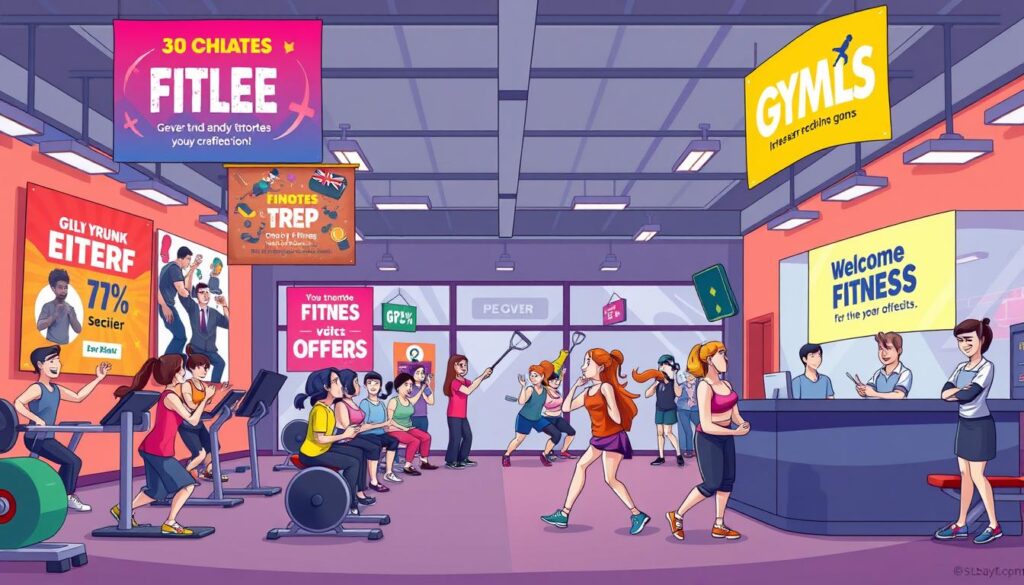
| Promotion Type | Description | Target Audience | Potential Impact |
|---|---|---|---|
| Seasonal Promotions | Limited-time discounts aligned with holidays or events | New members seeking to join during peak times | Increased sign-ups and excitement around the event |
| Loyalty Discounts | Rewards for existing members who stay or refer others | Current members and their referrals | Higher retention and community building |
| Group Discounts | Special rates for groups or corporate memberships | Businesses or friends looking to join together | Expand membership base and create community |
| First Month Free Offers | Free access for new members to try out | Members hesitant about committing | Encouragement to join long-term if they enjoy the experience |
Strengthening Community Engagement
Building a strong community in your gym is key to keeping members loyal. Good gym marketing strategies help a lot. When members feel seen and valued, they stick around longer and are happier.
Organizing Events and Challenges
Hosting fitness challenges, workshops, and social events helps members bond. It’s a great way to build friendship and a bit of friendly competition. Over 90% of fitness companies have rewards programs to keep members engaged.
Adding fun and challenges to workouts makes them more fun and memorable. This approach boosts engagement by 47%.
Collaborating with Local Businesses
Working with local businesses strengthens your gym’s ties to the community. You can co-host events or promote each other’s services. This not only grows your gym’s visibility but also builds a support network.
For example, teaming up with health food stores can lead to joint promotions. Offering discounts at these places adds value and enriches the community experience.
These strategies bring long-term benefits. A strong community means happier, more loyal members. This leads to more revenue from existing members, with 65% of a company’s revenue coming from repeat customers.
By fostering a lively community, gyms improve member interactions and business growth.
| Engagement Strategy | Benefit | Statistical Impact |
|---|---|---|
| Organizing Events | Increases member interaction | 47% boost in engagement |
| Rewards Programs | Enhances member loyalty | 86% faster revenue growth |
| Social Media Engagement | Strengthens community ties | Higher online interaction |
| Collaborations | Expands marketing reach | Increased visibility |
For more tips on improving engagement, check out effective SEO services to boost your local presence.
Measuring Marketing Success
It’s crucial for gyms to know how well their marketing works. They can use different metrics to check their success. By tracking important KPIs, gyms can spot trends, see what’s working, and find what needs bettering.
Key Performance Indicators to Track
- Return on Investment (ROI): A key measure of marketing success.
- Sales Numbers: Gives quick insights into how well marketing is doing.
- Unique Visitors: Shows how many new people are checking out the gym online.
- Bounce Rate: Tells if the website keeps visitors or loses them fast.
- Customer Satisfaction: Surveys and reviews show what’s good and what needs work.
- Retention Rate: Keeps members coming back, which is cheaper than getting new ones.
Tools for Analyzing Marketing Performance
Using the right tools helps gyms understand their marketing better. Here are some good ones:
| Tool | Functionality |
|---|---|
| Google Analytics | Tracks website traffic, user behavior, and engagement, giving insights into digital marketing. |
| CRM Software | Manages customer interactions and data, helping improve keeping and getting new members. |
| A/B Testing Platforms | Compares different marketing strategies to see which works best. |
| Social Media Analytics | Measures how well social media is doing, including follower growth and ad success. |
By using these KPIs and tools, gyms can make their marketing better. This leads to stronger results and growth.
Adapting to Trends in Fitness Marketing
Gym memberships have hit a record high of 184 million worldwide. This makes it key for gyms to keep up with new fitness marketing trends. With more millennials and Gen Z joining gyms, there’s a big push for tech in workouts. Gyms need to update their marketing to appeal to these new members.
Staying Ahead of the Competition
Gyms must adapt to changes like AI in fitness. This tech helps make workouts more personal and keeps members coming back. Using SEO and social media helps gyms reach more people online.
Sharing content from members and working with influencers also builds a strong community. This shows real experiences that attract new clients.
Incorporating Technology into Marketing Strategies
Short fitness videos and live streams are great for gym marketing. They keep workouts fresh and interesting. By knowing what members want, gyms can market better.
Understanding and solving member problems builds trust. This creates a loyal group ready for new fitness ideas.

